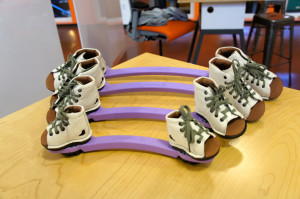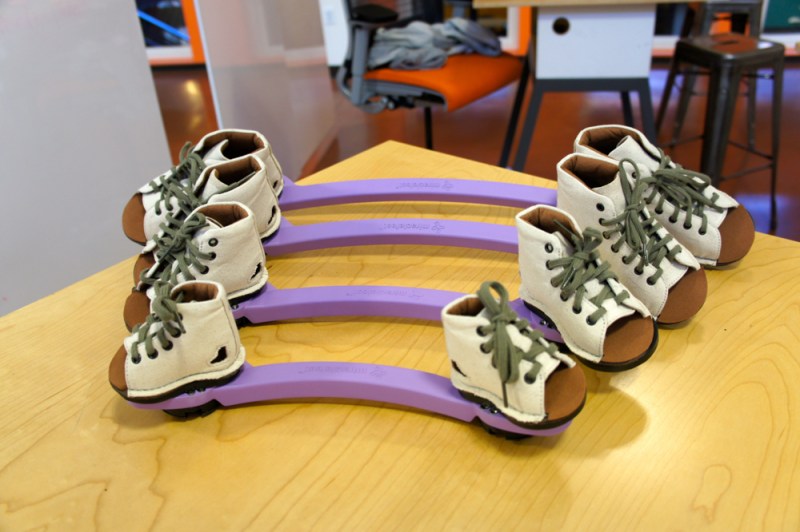
Every year, 150,000 children are born with clubfoot, a debilitating birth defect that causes an infant’s feet to turn inwards, crippling them and making them seem as if they are walking on their ankles.
While clubfoot can be treated in most cases, the current solution involves a multiple-year process of bearing heavy and uncomfortable shoes attached to steel braces, posing significant challenges to infants’ physical mobility—all at a cost of $700 per pair.
Ian Connolly ‘11 M.S. ‘13 and Jeffrey Yang Ph.D. ‘14 first encountered this problem through the Hassno Plattner Institute of Design (d.school), in a class called Design for Extreme Affordability. The class allows students to work in teams developing products and services that serve the needs of the world’s poor. Through the class, the duo partnered with Miraclefeet, a non-profit organization that provides low-cost clubfoot treatment in the developing world.
In collaborating with the nonprofit and doing fieldwork, Connolly and Yang designed and manufactured customized shoes that interface with light plastic braces to not only allow children with clubfoot to stand and walk while receiving therapeutic treatment but also reduce the mass-production manufacturing cost from $700 to less than $20 dollars a pair.
“In our mind, this is the fastest way to have real impact,” Yang said. “We’re not really interested in starting a business of our own. But being able to create a device that works and could be used in the field is really important to us.”
The drawing board
The duo’s attraction to the project began when they first spoke with Miraclefeet representatives in 2012.
“What makes this project unique is that the benefit that you are making is something that lasts for a very long time,” Connolly said. “Physical mobility is very basic, and every kid should have a chance.”
Prior to the partnership with Connolly and Yang, Miraclefeet mainly obtained low-cost braces by recycling them from higher-end customers or contacting local orthopedic manufacturers to produce them at low cost. Despite successfully making clubfoot braces affordable for poor families, the braces themselves were poorly designed and barely functional.
It wasn’t until the duo first visited Brazil through their d.school class, talking to parents, children and local clinical practitioners, when they really started to understand what the critical features of the braces were.
“It really gives you a lot of insight into why bracing is such a struggle and the many different places where things become difficult and compliance can be compromised,” Yang said.
According to Connolly and Yang, the fieldwork that constitutes a need-finding process helps them design the products from the users’ perspective as opposed to blindly applying theories without practical foundations. This process of understanding the needs of the world’s poor through ethnographic fieldwork is part of d.school’s human-centered design process.
Fieldwork also allowed Connolly and Yang to build empathy with the underserved population. Yang recalled a memorable encounter during a home visit in Brazil when a grandmother had to keep propping up a baby to on its side because the infant, wearing heavy braces, could not move on his own.
“I think going on those home visits…made us realize that we really need to make something that is affordable first and foremost because people really don’t have much [to give],” Connolly said.
Manufacturing the product
Coming back from Brazil, the duo sketched out a design idea based on their observations during the trip.
The real challenge lay in turning those ideas into manufactured products. Fortunately, Connolly and Yang were connected with Clarks shoes and Suncast Corporation, which helped them arrange a deal to manufacture the braces.
“I think they have done a terrific job at getting two big firms…involved,’ said James Patell, professor at the Graduate School of Business, one of the instructors of the d.school course that started the project.
Before it launches in Brazil, India and South Africa, the duo will confront some challenges. One of them is to raise awareness of clubfoot treatment among people in developing countries.
“In some of the clinics that we’ve been to, I heard a mother who tells me that her child was born with clubfoot at a hospital and no one told her there was anything wrong with her child,” Yang said. “Her sister looked at the child and recognized that there was something weird about his feet.”
With full-scale manufacturing underway, the duo is hoping to provide treatment for 15,000 kids by the end of the year.
Contact Helin Gao at helingao ‘at’ stanford ‘dot’ edu.
